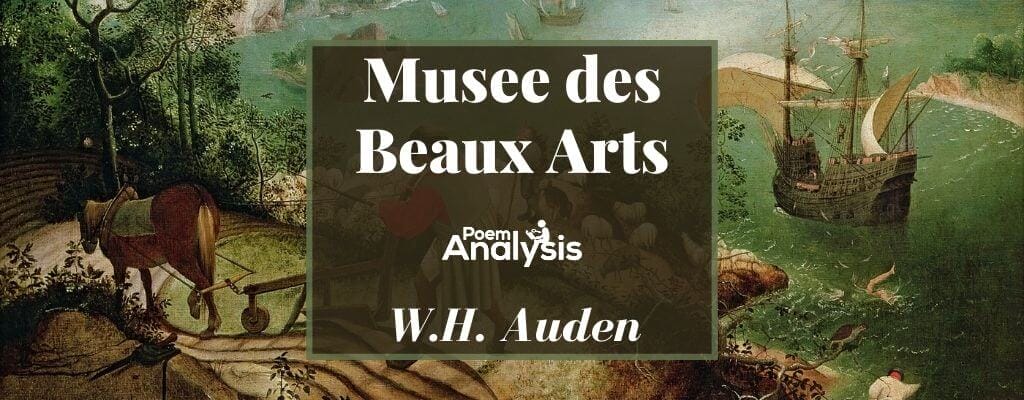‘Musee des Beaux Arts,’ or ‘Museum of Fine Arts,’ by W.H. Auden is a free verse poem that is separated into two parts, or stanzas. It was written in December of 1938 while the poet was living in Brussels, Belgium. When it was first published it appeared under the title, ‘Palais des beaux arts,’ or ‘Palace of Fine Arts.’ The modernist magazine New Writing published it in their Spring 1939 issue.
The title of the poem is drawn from the Musées Royaux des Beaux-Arts de Belgique in Brussels, an institution which is known for its extensive collection of Early Netherlandish paintings. It housed works which the poet would later refer to as those done by “Old Masters”.
Summary of Musee des Beaux Arts
The poem begins with the speaker stating that the “Old Masters” who were responsible for the art he was looking at, knew struggle well. Through their paintings, they were able to portray suffering in a way that most people never see it. It goes on in the background while others sit, eat, and go about their normal lives.
He continues on to say that suffering can take many forms and even revolve around the same event, such as the birth of a child. In the final lines of the first stanza, the speaker mentions martyrs and how their sacrifice is never properly appreciated. It fades into the background and is overtaken by the mundane world.
In the second stanza, he refers directly to a piece of art, Landscape with the Fall of Icarus. In this work, one can observe Icarus falling into the sea in the bottom right-hand corner. In the foreground, there are figures ploughing the land and preparing to sail. No one notices the boy’s suffering or if they do, they make no effort to help. Their lives take precedence over another’s struggle.
You can read more poetry by W.H. Auden here.
Analysis of Musee des Beaux Arts
Stanza One
About suffering they were never wrong,
The old Masters: how well they understood
Its human position: how it takes place
(…)
Anyhow in a corner, some untidy spot
Where the dogs go on with their doggy life and the torturer’s horse
Scratches its innocent behind on a tree.
While the second stanza speaks more definitively on one piece of art, the first gives the reader a wide-ranging description of the skills of the “Old Masters” and how their art spoke on suffering little known to the normal man or woman.
The poem begins with the speaker stating that the “Old Masters” were “never wrong” about suffering. They understood its ins and out very well. The master painters to whom the speaker, who is likely Auden himself, refers were able to depict the “human position” which can be seen in suffering. They made real the struggles and passions of humankind.
The next phase, which is the longest of the poem at fourteen words, lists out the different activities one might be engaging in while another is suffering unspeakably. People will be…
[…] eating or opening a window or just walking dully along;
Through this long line the speaker is hoping to convey the mundanity which accompanies suffering in everyday life. The human experience is made up of equal parts boredom, joy, and horror.
In the next part of the stanza, the speaker goes into the conflicting emotions which exist around one event, such as the birth of a child. There are those who feel it is “miraculous,” then there are the children who do not “specially want it to happen.” They are not looking forward to the birth of another sibling.
The final lines of the first stanza describe the speaker’s outlook on the importance of suffering and how it is, or is not, remembered. For a moment one’s sacrifice might be remembered, but before long it fades into history. It “run[s] its course.” It will waste away in a corner where more mundane happenings have taken precedence— a dog living its life and a horse scratching “its innocent behind.”
Literary and art scholars have suggested that the moments refers to in this section of the poem refer to two additional paintings Auden would’ve been able to see in the Musées Royaux des Beaux-Arts de Belgique.
Stanza Two
In Breughel’s Icarus, for instance: how everything turns away
Quite leisurely from the disaster; the ploughman may
(…)
Something amazing, a boy falling out of the sky,
Had somewhere to get to and sailed calmly on.
The second stanza of ‘Musee des Beaux Arts,’ which contains eight lines, speaks on the painting Landscape with the Fall of Icarus, which was at the time of the poem’s composition, thought to be by Pieter Bruegel the Elder. Today it is considered to be a copy of lost work. In the second stanza, the reader will encounter the technique of “ekphrasis.” This refers to a vivid verbal description of a piece of art. It comes from the Greek for the description of a piece of art created as a rhetorical exercise.
The speaker makes it clear from the first line of the second stanza which works he is speaking of. It is important to his narrative that the reader has a full understanding of what he was looking out for. The painting is utilized as an example of how suffering can be occurring quite close by and be far beyond what anyone sees. In the painting, there are a number of different figures all of whom
[…] turn away
Quite leisurely from the disaster;
The disaster which the speaker is describing is that of Icarus falling from the sky into the ocean. A splash, and pair of white legs, can be seen in the water in the bottom right-hand corner of the immediate scene. There might be someone in the scene who heard the “splash” or the “cry,” such as the “ploughman” but he does not react if that is the case. He continues his work, that being the most important part of his life.
In the second half of the stanza, the speaker describes how the sun shines on all parts of the scene equally. It warms the sea, the ploughman, and the “white legs” which have just recently disappeared “into the green / Water.” This paints a picture of the world being without mercy or sympathy. There is no change, even momentarily, in the state of the landscape.
The final lines of ‘Musee des Beaux Arts’ describe the “delicate” ship which can be seen in the green water of the painting. The speaker thinks that it certainly saw something, such as a boy falling into the ocean, but chose to do nothing about it. There is something of greater importance to the sailors—somewhere they are more interested in going than to investigate a splash. Everyone is calm, carrying on with their lives as if nothing happened.





My favorite website to study poem analysis
Thank you. I am glad we are your favourite. Tell your friends!
Please analyse Partition by WH Auden.
Hello, you can request an analysis here.